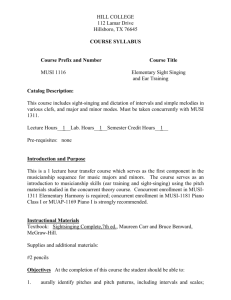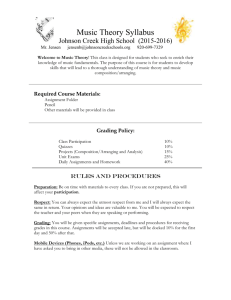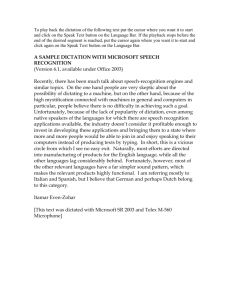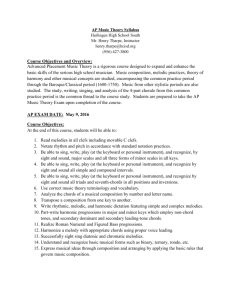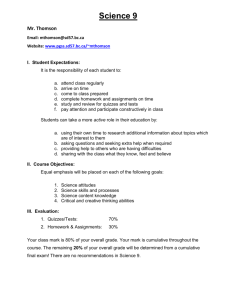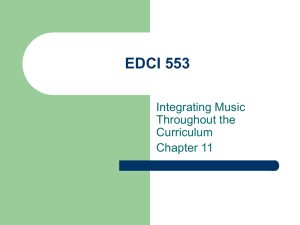AP Music Course Syllabus
advertisement
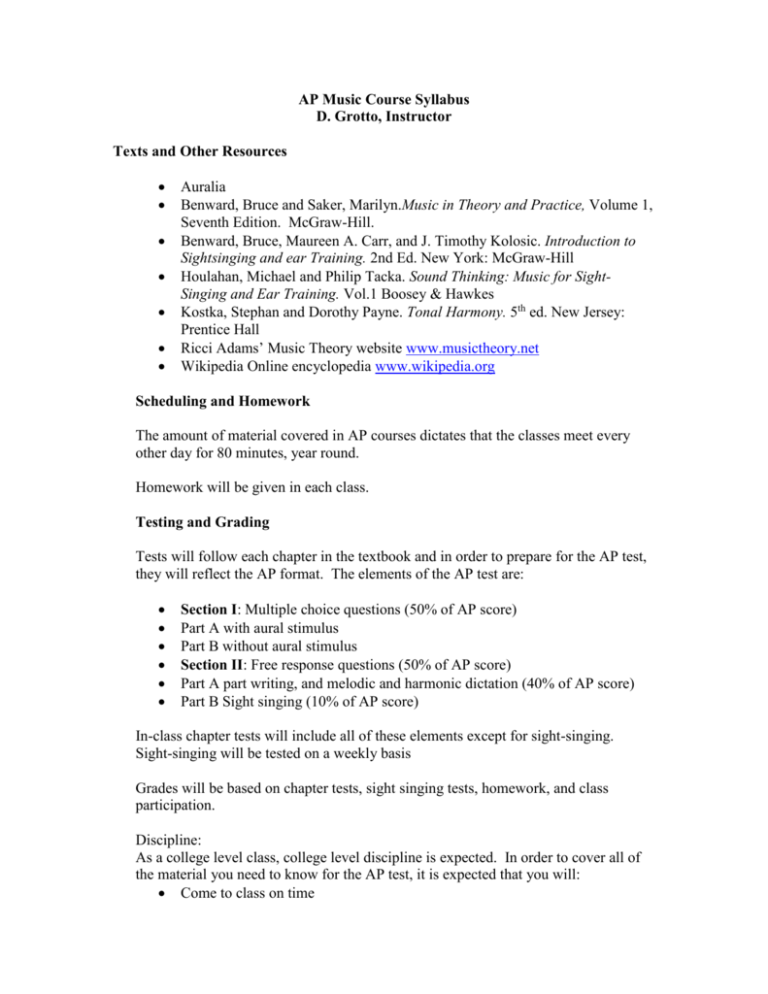
AP Music Course Syllabus D. Grotto, Instructor Texts and Other Resources Auralia Benward, Bruce and Saker, Marilyn.Music in Theory and Practice, Volume 1, Seventh Edition. McGraw-Hill. Benward, Bruce, Maureen A. Carr, and J. Timothy Kolosic. Introduction to Sightsinging and ear Training. 2nd Ed. New York: McGraw-Hill Houlahan, Michael and Philip Tacka. Sound Thinking: Music for SightSinging and Ear Training. Vol.1 Boosey & Hawkes Kostka, Stephan and Dorothy Payne. Tonal Harmony. 5th ed. New Jersey: Prentice Hall Ricci Adams’ Music Theory website www.musictheory.net Wikipedia Online encyclopedia www.wikipedia.org Scheduling and Homework The amount of material covered in AP courses dictates that the classes meet every other day for 80 minutes, year round. Homework will be given in each class. Testing and Grading Tests will follow each chapter in the textbook and in order to prepare for the AP test, they will reflect the AP format. The elements of the AP test are: Section I: Multiple choice questions (50% of AP score) Part A with aural stimulus Part B without aural stimulus Section II: Free response questions (50% of AP score) Part A part writing, and melodic and harmonic dictation (40% of AP score) Part B Sight singing (10% of AP score) In-class chapter tests will include all of these elements except for sight-singing. Sight-singing will be tested on a weekly basis Grades will be based on chapter tests, sight singing tests, homework, and class participation. Discipline: As a college level class, college level discipline is expected. In order to cover all of the material you need to know for the AP test, it is expected that you will: Come to class on time Be prepared with your textbooks, a pencil, a notebook, and staff paper Complete all homework on time Pay attention to the instructor and other students Actively participate in class. The Calendar Week Chapters in Theory and Practice and additional Assignments 1 1.Notation Letter names, clefs, octave identification, accidentals, rhythm, meter, enharmonic equivalents. Additional Assignment: Tonal Harmony Chapter 2 – Elements of Rhythm: meter, simple and compound time signatures, duration of symbols, division of beat. Unit 1: Sections A,B,C Sight singing (SS): 1,2,&3 beat values, diatonic models. Ear Training (ET): Rhythm Dictation full beat and half beat values. Auralia (A): Scale recognition level 1 2 Chapters in Theory and Practice and additional Assignments 2. Scales, Tonality, Keys, Modes Diatonic scales, solfeggio syllables, major scales, Minor scales, scale degree names, tonality. Chapter in Sight Singing Unit 1:Sections D,E,F,G SS: melodic fragments, short melodic structures, melodies using major and minor 2nds ET: Melodic dictation in conjunct, diatonic melodies A: Rhythm dictation level 1 3 Chapters in Theory and Practice and additional Assignments 2. Scales, Tonality, Keys, Modes Scale relationships, key centers. Baroque and Roman period Chapter in Sight Singing Unit 1: Sections H,I,J,K,l SS: Major melodies focusing on P4,P5,M3, ensemble excerpts with 2 voices ET: chord identification of major and minor triads, harmonic function of I and V chords. A: Scale recognition level 1-2 and rhythm dictation level 1 4 3. Intervals and Transposition Intervals and interval numbers, Perfect, major and minor. Additional Assignments: Tonal Harmony Chaper 1 – intervals in perfect, major, minor, augmented and diminished. Chapter in Sight Singing Unit 2:Sections A,B,C SS: compound meter, interval up to P5 and melodic fragments using intervals up to P5 ET: Rhythmic dictation in duple and triple subdivision A: Melodic dictation level 1 5 Chapters in Theory and Practice and additional Assignments 3. Intervals and Transposition Consonance and dissonance, augmented and diminished intervals, enharmonic intervals and inversions. Additional Assignments: interval trainers at www.music theory.net Chapter in Sight Singing Unit 2:Sections E,F,G,H SS: melodies using intervals up to P5 ET: Major scales and 3 forms of the minor scale A: Scale recognition level 2 6 Chapters in Theory and Practice and additional Assignments 4. Chords Triads, major and minor triads, diminished and augmented triads, and root position. Additional assignment: chord trainers at musictheory.net Chapter in Sight Singing Unit :Sections I.J.K.l SS: ensemble excepts with 2 voices ET: Chord identification of major, minor and diminished triads, harmonic function of I,IV,V triads A: Melodic dictation level 1 7 Chapters in Theory and Practice and additional Assignments 4. Chords and 5. Cadences and Nonharmonic tones Triads on scale degrees, harmonic analysis, Roman numeral analysis, seveth chords, figured bass, phrases, harmonic and rhythmic cadences. Chapter in Sight Singing Unit 3 :Sections A,B,C,D SS: rhythms with half-beat values, interval study introducing P8 ET: Rhythmic dictation using full and half beat values A: Chord dictation level 1 8 Chapters in Theory and Practice and additional Assignments 5.Cadences and Nonharmonic tones Nonharmonic tones, unaccented and accented nonharmonic tones, Music history. Additional Assignment: Listen to 3 Bach Chorales and identify all of the cadences and nonharmonic tones. Chapter in Sight Singing Unit 3 :Sections E,F,G,H SS: Melodies within the major triad and additional minor melodies ET: Models and embellishments, melodic dictation using m2,M2,M3 A: Chord recognition level 4, melodic dictation level 2, cadences level 1 9 Chapters in Theory and Practice and additional Assignments 6. Melodic organization The motive and the sequence. Chapter in Sight Singing Unit 3: Sections I,J,K,L SS: Ensemble excerpts in 2 voices outlining P5,P4,M3,m3 ET: Chord identification, triad factors in the soprano and harmonic function of the I, ii and V triads A: Cadences level 1 10 Chapters in Theory and Practice and additional Assignments 6. Melodic Organization False sequence, phrase, melodic structure. Chapter in Sight Singing Unit 4 :Sections A,B,C,D SS: quarter beat values, introduction of the m10 interval and melodic fragments that include m10 ET: Rhythmic dictation using half-beat values and syncopation. A: Cadences levels 1,2. Melodic dictation levels 2,3 11 Chapters in Theory and Practice and additional Assignments 7. Texture and textural reduction Texture and texture types. Chapter in Sight Singing Unit 4 :Sections E,F,G,H SS: Melodies in major and minor ET: Descending 3rds in 2 voices A: Scale recognition level 4 12 Chapters in Theory and Practice and additional Assignments 8. Voice leading in Two Voices Voice leading and species counterpoint. Tonal Harmony Chapter 5 Melodic line, notating chords, parallel motion Chapter in Sight Singing Unit 4 :Sections I,J,K,L SS: create original compositions for the class to sing ET: Harmonic function: distinguishing among the I,ii,IV,V triads A: Chord recognition level 3 13 Chapters in Theory and Practice and additional Assignments 8. Voice leading in Two Voices Voice leading, the cantus firmus. Chapter in Sight Singing Unit 5 :Sections A,B,C SS: introduction of the triplet and M6,M6 ET: Rhythmic dictation, quarter beat values 14 Chapters in Theory and Practice and additional Assignments 8. Voice leading in Two Voices Voice leading, motions between voices, composing 1st species counterpoint, principles of voice leading. Chapter in Sight Singing Unit 5: Sections D,E,F,G SS: folk melodies using intervals up to m10 ET: Descending 6th in 2 voices and melodic dictation of scalewise passages and arpeggiations of I and V A: Melodic dictation level 3, Scale recognition level 6, cadences level 2 15 Chapters in Theory and Practice and additional Assignments 8. Voice leading in 2 Voices Analyze 3 simple fugues. Chapter in Sight Singing Unit 5 :Sections H,I,J,K,L SS: ensemble excerpts in 2 voices ET: Harmonic function of the I,ii0,iv, V with inversions A: review all levels 16 Chapters in Theory and Practice and additional Assignments 9. Voice leading in 4 Voices 4 voice texture, Bach Chorales, analysis of the Chorale phrase. Chapter in Sight Singing Unit 5 :Sections A,B,C SS: more difficult rhythms using quarter beat values and melodic fragments using M6,m6 ET: review all levels 17 – WINTER BREAK 18 Tonal Harmony Chapter 6 – Root position part writing, four part textures Chapter in Sight Singing Unit 6: Sections E.F.G ET: Melodies outlining I,IV,V,viio A: Cadences level 3 19 Chapters in Theory and Practice and additional Assignments 9. Voice leading in 4 Voices Stylistic practices, root position composition, exceptions to stylistic practices and 1st inversion triads. Additional assignment: Listen to and analyze 4 chorales. Chapter in Sight Singing Unit 6: Sections H,I,J,K,L SS: ensemble excerpts review, introduction of 4 voices ET: Triad identification highlighting factors in the soprano and bass voices A: Cadences level 4 20 Chapters in Theory and Practice and additional Assignments 10. Harmonic progressions and harmonic rhythm Harmonic progressions, chord progressions, harmonic rhythm. Chapter in Sight Singing Unit 7: Sections A,B,C.D SS: Emphasis on the triplet and introduction of the m7 ET: Rhythmic dictation with beats divided into triplets 21 Chapters in Theory and Practice and additional Assignments 10. Harmonic progressions and harmonic rhythm How to harmonize a tonal melody. Chapter in Sight Singing Unit 7: Sections E,F,G,H SS: melodies to be performed at performance tempo ET: 7-3 patterns in 2 voices and melodic dictation highlighting intervals of a 7th A: Melodic dictation level 4 22 Chapters in Theory and Practice and additional Assignments 11.Dominant Seventh Chords Dominant 7th chords, macro analysis symbols, music history. Chapter in Sight Singing Unit 7: Sections I,J,K,L SS: ensemble excerpts in 2 and 3 voices ET: nonharmonic tones and I,iio,iii,IV,V,vi inversions 23 Chapters in Theory and Practice and additional Assignments 11. Dominant Seventh Chords Resolution of the dominant 7th chord, circle progression, nonresolution of the 7th factor. Chapter in Sight Singing Unit 8: Sections A,B,C,D SS: intervals using M7,m7 ET: Cadences in 2 voices A: Melodic dictation level 5 24 Chapters in Theory and Practice and additional Assignments 12. Leading Tone Seventh Chords Leading tone 7th chords, progressions from viio and viio7. Chapter in Sight Singing Unit 8: Sections E,F,G,H SS: melodies for review and practice at performance tempo ET: Two phrase melodies A: melodic dictation level 5, cadence identification level 4, harmonic progression level 3 25 Chapters in Theory and Practice and additional Assignments 12. Leading Tone Seventh Chords Macro analysis symbols and application of voice leading in the 7th Chord. Chapter in Sight Singing Unit 8: Sections I,J,K,L SS: ensemble excerpts in 2,3,4 voices ET: harmonic dictation of I, ii, iv, V triads in 4-part chorale phrases A: Melodic dictation level 4, 5 26 Chapters in Theory and Practice and additional Assignments 13. Nondominant Seventh Chords Nondominant 7th chords in circle progressions, non-circle treatment, resolution of 7th factor. Chapter in Sight Singing Unit 9: Sections A,B,C,D SS: subdivision of the beat in compound meters, diatonic and chromatic models using A4 and d5 ET: 7-3 patterns in 2 voices and melodic dictation highlighting intervals of a 7th A: Compound meters with quarter beat values 27 Chapters in Theory and Practice and additional Assignments 14. Modulation Modulation, closely related keys, phrase modulation, chromatic modulation, analytical symbols for modulation. Chapter in Sight Singing Unit 9: Sections E,F,G,H SS: melodies designed for speed singing ET: melodies with larger leaps and chord progression A: Scale recognition level 9, melodic dictation levels 4,5 28 Chapters in Theory and Practice and additional Assignments 15. Secondary Dominants and Leading Tone Chords Secondary dominants and leading tone chords. Chapter in Sight Singing Unit 9: Sections I,J,K,L SS: ensemble excerpts in 2,3,4 voices ET: the tritone and dictation in 4 part chorales 29 Chapters in Theory and Practice and additional Assignments 16. Two-part (binary) form Formal divisions, open vs. closed formal divisions, 2 part form. Additional assignment: Listen to Bach’s Gavotte I from English Suite. Analyze the harmonic and melodic structure. Compose your own binary piece in 16 mm using tonal elements from the Gavotte Ear training and sight singing examples in test format. 30 – SPRING BREAK 31 Twentieth Century Music Whole tone scales, 12 tone rows, serialism, atonal music. Additional Assignment: Compose your own song using a 12 tone row Ear training and sight singing examples in test format. 32 Chapters in Theory and Practice and additional Assignments 17. Three part ternary form Three part form, expanded ternary form, rounded binary form. Ear training and sight singing examples in test format. 33-35 Review and sample tests. Built-in extra time. 36 AP TESTING 37 After AP Testing – Material to be announced: Original compositions, instrumental transposition…

